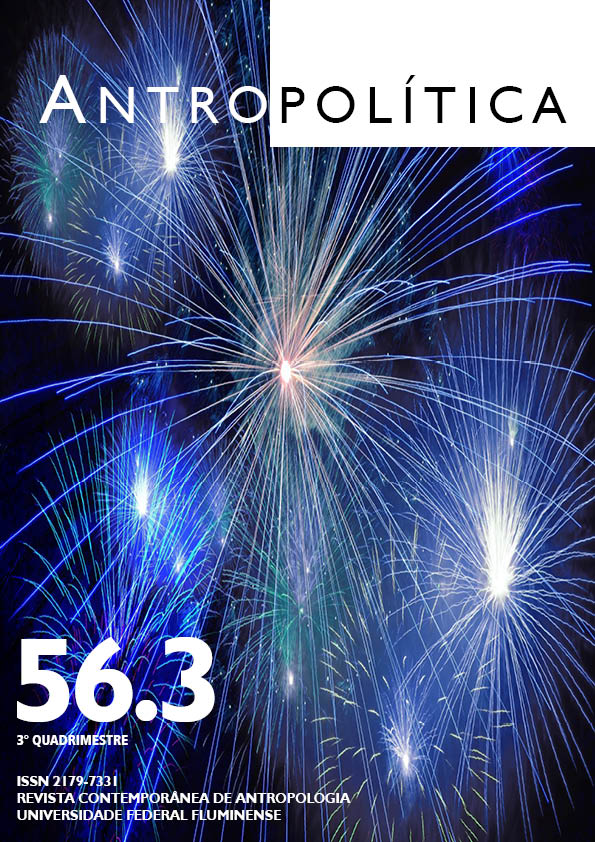Presentarion: Charisma: power, authority, and devotion in the Middle East and North Africa
DOI:
https://doi.org/10.22409/antropolitica2024.v56.i3.a65709Keywords:
Max Weber, Charisma, Ethnography, Middle East and North Africa.Abstract
Since the publication of Max Weber’s foundational work on the conceptualization of charisma, the concept has been subject to a wide range of interpretations, often marked by contradictions. Acknowledging the fragmentary nature of Weber’s framework, this special issue examines the concept of charisma from an anthropological perspective, engaging with Weber’s theoretical model to explore the diverse forms and manifestations through which charisma is created and legitimized. Ethnographies conducted in religious contexts across the Middle East and North Africa have shed light on the various configurations of charismatic communities, movements, and relations, which produce multiple forms of emotional expression and religious experience. In order to contribute to the anthropological debate on the applicability of Weber’s concept to different forms of charisma in distinct social and religious contexts, this collection features five ethnographic accounts from Turkey, Morocco, Lebanon, and Iraq. These studies explore the processes through which charisma is constructed, maintained, and transmitted across different religious, political, and institutional contexts. By integrating Weberian theory with ethnographic perspectives, this issue seeks to advance our understanding of charisma as a dynamic, relational, and culturally embedded phenomenon. The contributions to this issue deepen our insight into diverse forms of religious and political commitment, belonging, and emotional attachment to a religious leader, community, or movement, fostering a productive dialogue between different analytical perspectives and ethnographic contexts.
Downloads
References
BOURDIEU, Pierre. Legitimation and structured interests in Weber’s sociology of religion. In: LASH, Scott; WHIMSTER, Sam (ed.). Max Weber: Rationality and Modernity. London: Allen and Unwin, 1987. p. 119-136.
BREUER, Stefan, The Relevance of Weber’s Conception and Typology of Herrschaft’. In: HANKE, Edith; SCAFF, Lawrence; WHIMSTER, Sam (ed.). The Oxford Handbook of Max Weber. Oxford: Oxford University Press, 2019.
CHAGAS, Gisele Fonseca. Female Sufis in Syria: Charismatic Authority and Bureaucratic Structure. In: Lindholm, Charles (ed.). The Anthropology of Religious Charisma. New York: Palgrave Macmillan, 2013. p. 81-100. (Contemporary Anthropology of Religion).
DOUGLAS, Mary. Natural Symbols. New York: Routledge, 1996.
EISENSTADT, Shmuel. Introduction. In: WEBER, Max. On Charisma and Institution Building. Selected writings. Chicago: University of Chicago Press, 1968. p. xix-lvi.
HUTT, Curtis. Pierre Bourdieu on the Verstehende Soziologie of Max Weber. Method & Theory in the Study of Religion, [s. l.], v. 19, n. 3-4, p. 232-254, 2007.
LINDHOLM, Charles. Charisma. Oxford: Blackwell, 1993.
LINDHOLM, Charles. The Anthropology of Religious Charisma. Contemporary Anthropology of Religion. New York: Palgrave Macmillan, 2013.
MIYAHARA, Kojiro. Charisma: From Weber to Contemporary Sociology. Sociological Inquiry, [s. l.], v. 53, n. 4, p. 368-388, 1983.
PINTO, Paulo. Knowledge and Miracles: Modes of Charisma in Syrian Sufism. In: LINDHOLM, Charles (ed.). The Anthropology of Religious Charisma. New York: Palgrave Macmillan, 2013. p. 59-77. (Contemporary Anthropology of Religion).
PINTO, Paulo. Mystical bodies/unruly bodies: Experience, empowerment and subjectification in Syrian Sufism. Social Compass, [s. l.], v. 63, n. 2, p. 197-212, 2016. Disponível em: https://doi.org/10.1177/0037768616628791. Acesso em: 12 dez. 2024.
RIESEBRODT, Martin. Charisma in Max Weber’s Sociology of Religion. Religion, [s. l.], v. 29, n. 1, p. 1-14, 1999.
SHILS, Edward. Charisma, Order, and Status. American Sociological Review, [s. l.], v. 30, n. 2, p. 199-213, 1965.
TEE, Caroline. Creating charisma online: the role of digital presence in the formation of religious identity. Journal of Contemporary Religion, [s. l.], v. 34, n. 1, p. 75-96, 2019. Disponível em: https://doi.org/10.1080/13537903.2019.1585104. Acesso em: 12 dez. 2024.
WEBER, Max. Economy and Society: An Outline of Interpretive Sociology. Oakland: University of California Press, 1968. [1922].
WERBNER, Pnina; BASU, Helene. The embodiment of charisma. In: WERBNER, Pnina; BASU, Helene (ed.). Embodying Charisma: modernity, locality and the performance of emotion in Sufi cults. New York: Routledge, 1998. p. 3-27.

Published
How to Cite
Issue
Section
License
Copyright (c) 2024 Gisele Fonseca Chagas, Liza Dumovich

This work is licensed under a Creative Commons Attribution 4.0 International License.
O conteúdo da revista Antropolítica, em sua totalidade, está licenciado sob uma Licença Creative Commons de atribuição CC-BY (http://creativecommons.org/licenses/by/4.0/deed.pt).
De acordo com a licença os seguintes direitos são concedidos:
- Compartilhar – copiar e redistribuir o material em qualquer suporte ou formato;
- Adaptar – remixar, transformar, e criar a partir do material para qualquer fim, mesmo que comercial;
- O licenciante não pode revogar estes direitos desde que você respeite os termos da licença.
De acordo com os termos seguintes:
- Atribuição – Você deve informar o crédito adequado, fornecer um link para a licença e indicar se alterações foram feitas. Você deve fazê-lo em qualquer maneira razoável, mas de modo algo que sugira que o licenciante o apoia ou aprova seu uso;
- Sem restrições adicionais — Você não pode aplicar termos jurídicos ou medidas de caráter tecnológico que restrinjam legalmente outros de fazerem algo que a licença permita.

